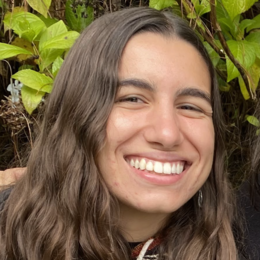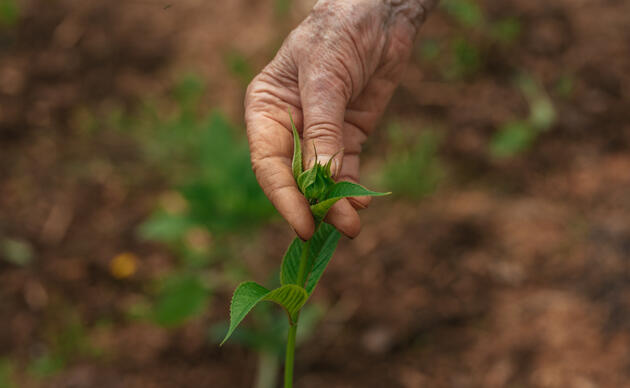"Food for us comes from our relatives, whether they have wings or fins or roots. That is how we consider food. Food has a culture. It has a history. It has a story. It has relationships."
This quote comes from Winona LaDuke, Indigenous Land-Back Activist and writer, of the Ojibwe White Earth Reservation.
Food, like one’s language, is full of value and meaning that is inseparable from the environments, both human and non-human beings, and interwoven histories of where one comes from. This season, as we cook with our families and catch up around the dinner table, may we begin to see our food as a deeper reflection of our ancestral foodways, of the environments that sustain us all. Our cuisines are not random assemblages of ingredients but instead are complex generational archives, largely cultural and land-based wisdom that tell the stories of our family histories, identities, migrations, time, and change.
As such, when we take away a community’s ancestral lands, we take away their right to their culture, foods, ceremonies, and reciprocal relationships with their lands and people; we reduce foods and the environments that uphold them to scraps. Therefore, to be able to reconnect, tend the traditional lands and native plants — those plants that had grown in a co-evolutionary symbiosis with ourselves — and cook with one’s own hands the foods that have sustained their gifts for generations is ultimately an act of sovereignty and preservation. As Dr. Robin Wall Kimmerer, member of the Citizen Potawatomi Nation and author of Braiding Sweetgrass, notes, it is a means of acknowledging that “all flourishing is mutual,” between that of our soils, plants, animals, and ourselves (Kimmerer 20-22).
This week I had the pleasure of meeting Dr. Kimmerer at the University of California, Santa Barbara where she engaged in a deep discussion of Indigenous sovereignty, language, food, and environmental care. What intrigued me the most from her conversation was her exploration of Indigenous languages as the stepping stones to which ethics of care and environmental stewardship find their foundations. Language captures that which may go untranslatable — it is the precursor, made ritualized through community, to understanding and connecting with the world around us. Reflecting on the grammar of animacy intrinsic to many Indigenous languages, it is all too clear the way we speak to and for our earthly relatives reinforces the ways in which we extend our gratitude or lack thereof.
Kimmerer notes how kincentricity rests comfortably within the linguistics of Indigenous languages, with their propensity to emphasize the animacy, dynamic spirit, and autonomy of each being. Where dominant Romance languages may maintain individualism, hierarchies of gender and race, discretely bound and binary-infused entities, Indigenous languages affirm the changes, the life that pulses through all things and identities rather than enforce permanence or fixed essence onto other beings. Indigenous languages prioritize the “we” over the “I,” understanding all life as fundamentally social, reliant, and where “people” includes plants, places, lands, animals, and all. Thus, it is not unexpected that learning and being involved in a culture dictated by languages of interconnectedness and linguistics that emphasize the inclusive animacy of all beings creates communities in tune with ecological care and humility. For English speakers, for example, a body of water, like a bay, is denoted via noun; it is then “defined solely by humans, trapped between its shores and contained by the word” (Kimmerer 55). And yet, when we open up that fixed noun to the Potawatomi verb of “wiikwegamaa” or “to be a bay,” the Potawatomi are able to embrace the ways we are interconnected, alive, animate, and imbued with a being that is subjective and personal as it is active and dynamic (Kimmerer 56).
Where Western, colonial culture is predicated on anthropocentric languages that define food as private property or commodity, nature as a stockpile of resources, and purport that “the only way to be animate, to be worthy of respect and moral concern is to be human,” many Indigenous languages and stories are able to relinquish any hierarchy of individualism. Instead, they are more inclined to recognize the connectedness and reciprocity between each of our plants, animals, and selves as one active, mutually dependent site of being (Kimmerer 57). When the language asks you to think of your ancestors and descendants as equal in relationship, it is not unexpected for that culture to then seek to sustain past knowledge, lands, and experiences to share with the future. This is essentially what Kimmerer illustrates in what she describes as “grammars of animacy,” in which she acknowledges how Indigenous languages with their tendency to embrace verbs over nouns, animacy over permanence or static language allow for “cultures of reciprocity” of caring for the lands for constant future regeneration.
When the American Ornithological Society (AOS) announced at the start of this month their intention to change the English common names of some birds, including all birds named directly after people, I could not help but think about the act of naming as means of sovereignty and a means to challenge the deeply rooted impacts of colonization upon our relationship to the land and our fellow beings. When we reexamine the ways we speak of the natural world and of our foodways, we can understand how we can better connect and relate to one another. We feel this clearly in observing the speech varieties of the Koyukon tribe of Alaska in speaking about their animal communities. Creatures are not named by humans per se, but “appear to name themselves” in essence by observing and listening to “their own enactments, habits, behaviors, personal narratives, and individual life stories” (Sinclair 7). This is starkly distinct from Western ways of naming as there is a shift in power between the observer and the observed, in which the Western observer assigns names, often their own names, to the observed and assumes ultimate control in that relationship.
For the Anishinaabe culture, the community does not purport to give the names but to receive them; their role as humans is not to control or change the world but to learn from the world how to be human (Kimmerer 207-9). The Koyukon receive the names of their relatives in the essence of carefully watching and getting to know them as they naturally are in their environments. Their names, thus, tell us something about the animal and how they relate to the natural world. In particular, their naming of the Green-winged Teal duck when translated to English denotes “knocked the swan down;” their Osprey is known as “stares into the water” (Sinclair 8). Notice how this naming is verb-oriented as opposed to the more fixed, static presence of more Western language structures. This language requires deep familiarity with those receiving a name; when communities speak to these peoples, they respectfully use these names to retell the stories from which they come.
These Koyukon naming examples also noticeably offer real information about the ecological relations existing in their landscape and environment. To call the Osprey one that “stares into the water,” the community then recognizes this bird of prey as specifically a fish-eating bird, a bird that thus resides close to oceans, rivers, lakes, and mangroves. Looking at the English naming of “Osprey,” it originated etymologically from Old French “ospreit,” which is a generic, umbrella term for any raptor (“Osprey Origins”). As we can deduce, this name does not offer the same level of personhood, place, identity, and ecology represented in that of the Koyukon. The Koyukon name attends to relationality, ensuring the name is actively representative of what is distinct and unique of that person in their environment. In this way, Indigenous naming may not so much distinguish or individuate one being from another, but instead “connects, situates, and embeds bodies..as cohabiting,” as representative of the true ecological interconnecting web of interacting species (Sinclair 10).
An often overlooked facet of colonialism is the way in which the history of forced monolingualism of Indigenous cultures, and the decimation of mother tongues simultaneously exacerbated a cultural and environmental disintegration. Weakening languages also decimates the health, survival, and process of Indigenous ceremonies, which are essential to the preservation of ecological and ethical wisdom, spirituality, ancestral, and familial bonds. Over the past 400 years, Indigenous languages across the US have been dying out, and over 200 have become extinct, leading to a major loss of ceremonial knowledge and practice (“Many Indigenous Languages”). And yet, we must understand that this statistic was a deliberate product of the mass cultural genocide and erasure of Indigenous cultures since colonization. Recultivating language is, thus, the work of remembering who you are and remembering who you take care of and what takes care of you.
In this reflection on food, language, and Indigenous wisdom, we are reminded that our nourishment transcends mere sustenance; it embodies culture, history, and interconnectedness. As we gather around tables laden with ancestral recipes, let us recognize the profound story each dish tells — of lands, relationships, and the legacy of generations past. Supporting the revitalization efforts of Indigenous languages, with their inherent kincentricity and grammar of animacy, is a crucial step towards honoring our environment and nurturing a sense of ecological stewardship. Moreover, the act of reclaiming traditional lands, native plants, and culinary practices isn't just an assertion of sovereignty; it's a profound commitment to preserving cultural heritage and fostering mutual flourishing between humanity and the natural world. Amidst this journey, we must acknowledge the harm caused by colonialism, particularly in the erasure of languages and the profound ecological knowledge embedded within them. Embracing reciprocity this season means embracing the interconnectedness of our existence — cherishing our families, communities, and the lands that sustain us.
Works cited
Kimmerer, Robin. Braiding Sweetgrass. Minneapolis, Minnesota: Milkweed Editions. 2013.
“Osprey Origins.” Virginia Institute of Marine Science, https://www.vims.edu/bayinfo/ospreycam/about/name/index.php#:~:text=The%20 common%20 English%20name%20is,%2Dbreaker%E2%80%9D)%2C%20a%20very.
Sinclair, R.“Righting Names.” Environment and Society, 9(1), 91–106. https://doi.org/10.3167/ares.2018.090107. 2018.





